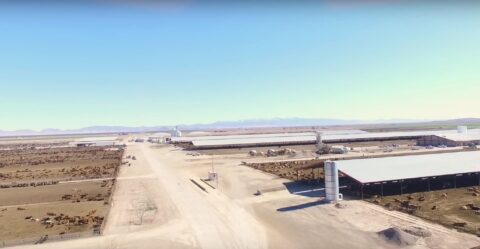Perspective
Critics Declared Veganism Dead in 2025. Here’s What Those Obituaries Are Missing.
Food•5 min read
Reported
Big Ag is the largest groundwater user in Sulphur Springs Valley, AZ—and it’s not slowing down. Companies continue to add cattle to their herds, depleting the valley’s water supply so much that residents are left without water to drink. Earlier this summer, we chatted with Noah Gallagher Shannon, the…


Words by Matthew Zampa
Big Ag is the largest groundwater user in Sulphur Springs Valley, AZ—and it’s not slowing down. Companies continue to add cattle to their herds, depleting the valley’s water supply so much that residents are left without water to drink. Earlier this summer, we chatted with Noah Gallagher Shannon, the author of a landmark feature for the New York Times Magazine, “The Water Wars of Arizona.” Here’s what he had to say about troubling times in a valley that could be without water a lot sooner than you’d think.
Sentient Media: You surfaced something that clearly resonated with people. Why water? And why now?
Noah Gallagher Shannon: It was a struggle from the beginning to think about how to make climate change-related reporting, resource-related reporting, water-related reporting interesting and animated. Water can be boring at times.
I was interested from the get-go in trying to tell a water story from a very human side, not to get too distracted by the minutiae of the science and the law and just try to contemplate on how these things are affecting families and affecting communities and affecting livelihoods. I felt like maybe that’s a way we can get more people to pay attention to what seems at least from the scientists that I talked to be a looming catastrophe.
SM: Well, you make a pretty compelling case that water can be interesting. Where’d you start?
NGS: I think what caught my eye and when I knew that it was a story was when I read about homes’ wells going dry. I think in the Southwest, people are sort of used to hearing that domestic wells have gone dry. You’ll read in a report 12 domestic wells have gone dry in a given area, but my interest was in the one well. What does it actually mean on a human level when a well goes dry? What does that do to the family? What does that do to the worth of the home? What does it do to the interaction of the family with the community?
I was seeking out a family whose well had gone dry, but that turned out to be another challenge because in Arizona at least at this time, the government doesn’t keep records of dry wells, doesn’t keep records of homes abandoned as a result of dry wells, et cetera. So I basically had to work backward by trying to think like a family whose well had gone dry. What would I do first? I’d probably look for pumps and tanks and other equipment that could satisfy my water supply in the short term. I started calling around to places that supply those and looking for water delivery services and contacting them.
SM: How did folks respond? Any reports of a suspicious New York Times journalist in town asking questions?
NGS: I really didn’t have the experience I think gets talked about so much in the press nowadays of rural communities being suspicious of the New York Times. I mean if they were, they were privately suspicious and maybe joked around a little bit with me about talking to the “failing” New York Times. But I think in the valley, the water problem was such an issue that they were happy to have anyone from the outside coming in and looking at it.
SM: I can’t imagine what that looked like.
NGS: Yeah. I think to many people, farms are such foreign landscapes, just in terms of what they look like. I think people are used to reading about thousand-acre farms, but that makes the true expanse tough to conceive until you’re looking at it.
Water’s like that too. It’s tough to know what a well pumping 2,000 gallons a minute looks like until you’re close to it. Wells even don’t look like what you’d expect them to look like. It’s a tube coming out of the ground attached to a motor. I’ve driven by a thousand of them probably not realizing what they were until someone took me in close and showed me how it worked.
SM: Let’s be honest, water is hard to talk about. Like most of the changes happening to our climate, there’s not a positive outcome in the near future, right?
NGS: Right. Well, and I think some of the reporting and some of the projections can make it seem like climate change is a future tense problem, but I think what I was trying to highlight is some of these things are already beginning to happen. Some people’s lives and people’s communities are already being drastically changed by drought and by declining surface and groundwater. I think telling those stories can be a little more relatable than people just reading projections about climbing degrees or the amount of water that’s going to be depleted 50 years from now given current withdrawal rates.
That’s not to say none of that stuff is important and vital and drives a lot of policy, but it sometimes doesn’t connect with readers I think as well as hearing about walking to your sink one day and having sand, and then eventually, nothing come out of it. My goal was to try to do something maybe a little more visceral–to nail down the human angle of these problems.